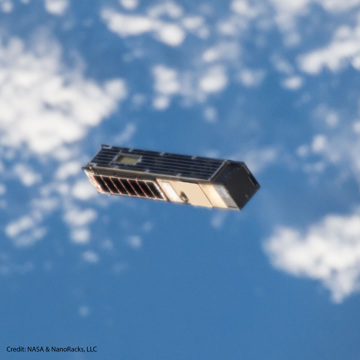Sierra Nevada Corporation’s New Solar Array Technology Provides 25 Percent More Power in First Flight
SPARKS, Nev., December 18, 2017 – Sierra Nevada Corporation’s (SNC) new Surface Mount Technology (SMT) solar array is operational and already providing 25 percent more power to its host spacecraft than a conventional solar array designed for the same application.
The revolutionary technology is being used on the Air Force Research Laboratory’s (AFRL) Satellite for the High Accuracy Radar Calibration (SHARC) mission, which was launched from the International Space Station via NanoRacks LLC earlier this year. Among other goals, SHARC is demonstrating calibration capabilities needed to track orbital objects such as satellites and debris. The SMT arrays have been successfully providing power on SHARC for the last few months.
“Platforms like the SHARC satellite help validate not only our missions, but other new technologies such as SNC’s SMT solar arrays,” said Kyle D. Kemble, Air Force Research Laboratory Mission Manager. “This mission is the perfect example of how small satellites, co-developed between government, academia and industry, can prove state-of-the-art technologies and determine the future of next-generation satellites,” added Kemble.
The SHARC solar panel is an efficient and agile product, was rapidly delivered to AFRL after the contract was awarded. The streamlined design, test and manufacturing process allowed the hardware to be completed in just three months. Future missions will continue to demonstrate this short time cycle for design and manufacturing phases – critical to the rapidly emerging small satellite constellation market.
“SNC is pleased to introduce our SMT solar arrays into the market to meet an ever-increasing demand in low-cost, low lead-time subsystems,” said John Roth, vice president of business development for SNC’s Space Systems business area.
“Future missions will benefit from our SMT technology in two possible ways. Spacecraft with the same-sized solar array as a traditional system will have more power for payloads, or the panel size could be reduced – giving that weight and volume to other critical systems. This provides our customers with design flexibility at a much lower cost,” Roth added.
Key benefits:
- The patent-pending technology offers a significantly higher watt density through automation and standardization.
- The manufacturing process supports broad scalability and high reliability by reducing human contact.
Power data from the SHARC mission is being used to confirm performance models and project expectations. Initial markets will be for 20W to 3kW range missions, but the technology can support large communication satellite power requirements.
About Sierra Nevada Corporation
Sierra Nevada Corporation (SNC) is a trusted leader in solving the world’s toughest challenges through advanced engineering technologies in Space Systems, Commercial Solutions, and Defense and National Security. Honored as one of the most innovative U.S. companies in space, SNC’s Space Systems business area designs and manufactures advanced spacecraft and satellite solutions, space habitats and environmental systems, propulsion systems, precision space mechanisms and subsystems, and SNC’s celebrated Dream Chaser® spacecraft. With more than 25 years of space heritage working with the U.S. government, commercial customers, and the international market, SNC has participated in more than 450 successful space missions and delivered 4,000+ systems, subsystems and components around the world. For more information, visit www.sncorp.com.
###
